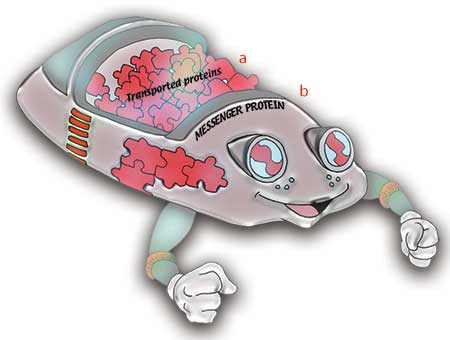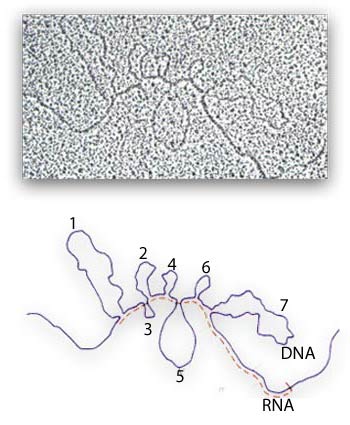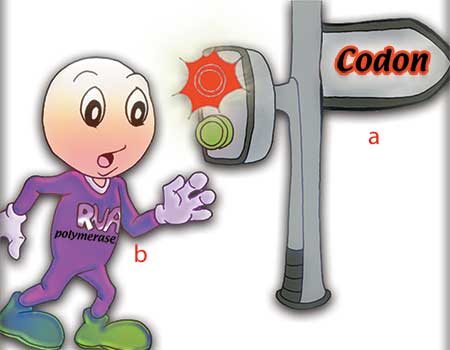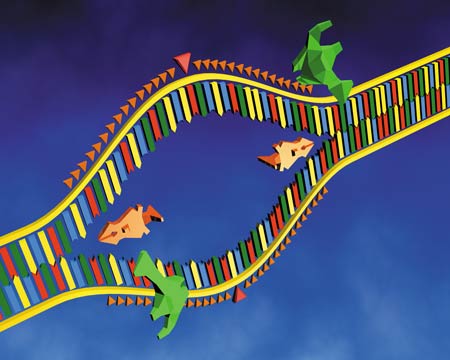Protein production in the cell is one of the miraculous phenomena created by God. Every cell operates like a factory, using the most advanced technology and organization. In this micro-world, which is visible only under the most powerful microscopes, extraordinary events take place.
Let us examine the main outlines of this protein factory that works with the most flawless and perfect efficiency:
 |
| a.Transported proteins |
| Figure 105: When a new protein needs to be produced, messengers which are themselves proteins, carry the request for protein production to the cells of the organ concerned. |
1. Whenever the body feels the need for any protein, a message expressing that need reaches the DNA molecule in the nuclei of the cells where that production is to take place. Here, a very important point is to be noted: Whenever there arises a need for any protein in the body, certain messengers—themselves proteins!—can find all the relevant locations in the body, know where they must go, and then transmit their message to the right place in the proper form. The protein that establishes this communications finds its way in the total darkness of the bloodstream, without losing its way, losing the message it carries or doing any harm to any part of it (Figure 105).
2. To request the formula for a protein from DNA, a special language is used. This language has an alphabet which scientists designate as consisting of four letters, A, G, C and T. The production of the appropriate protein is of the greatest importance in order that there will be no impairment of the processes inside the cell, and for the need to be met in an accurate manner—in short, to maintain the cell’s very survival. Therefore, after the message arrives concerning the need for a particular protein to be produced, the correct information needs to be selected and extracted from the DNA.
But who makes that selection? An enzyme known as RNA polymerase, whose work is exceptionally difficult. First and foremost, it must select the letters regarding the protein to be produced from among the DNA molecule, which consists of 3 billion letters. The way that RNA polymerase finds and extracts information of just a few lines from those 3 billion units of DNA information is comparable to finding a few specific lines in a foreign language, with no description or index of it being available, from an encyclopedia consisting of 1,000 volumes.
 |
| The regions marked 1 through 7 contain information that does not need to be "read." Enzymes set out these regions bend them to the outside, as shown in the illustration. |
3. In order for the copying process to begin, a very important obstacle has to be overcome. The entwined arms of the DNA molecule need to be separated, and this is again the task of RNA polymerase. Attaching itself to the first 3 letters of the gene to be coded, the RNA polymerase opens up the DNA rungs—which resemble a spiral staircase—as if it were unfastening a zipper. It does this at a very great speed. In fact, because of that very speed, there is a danger of the DNA heating up and getting damaged. Yet the system has been laid out so perfectly that this danger has been foreseen.
Thanks to a series of precautions taken beforehand, the danger of overheating is eliminated; as if it were aware of the possible danger, a special enzyme attaches to the ends of the opened DNA string and blocks this friction. As we’ve seen, special enzymes then prevent them winding around each other during the DNA opening process. Were it not for these enzymes, then it would be impossible for the order docket known as messenger RNA to be copied, because the arms of the DNA helix, parted like the teeth of a zipper, would again wind around each other before the copying process even began, and the resulting friction would damage the structure of the DNA. As we have seen, dozens of enzymes and proteins are involved in every stage of the process, yet all fulfill their responsibilities to the letter, in perfect harmony.
4. After these special precautions, there are still a few more hurdles to be overcome. For instance, the information containing the amino-acid sequence in the desired protein may lie anywhere in the long DNA molecule. In that case, how is the polymerase enzyme to copy codes indicating information—in other words, the amino-acid sequence— in different locations?
It cannot break the DNA, nor skip over unwanted codes. If it continues directly along the same lines, it will copy unnecessary data, and the desired protein will fail to appear.
 |
| a. Codon |
| Figure 106: When the enzyme RNA polymerase reaches the stopping codon, it understands that the copying must stop, and halts the process. |
The solution to this problem takes place with an extraordinary phenomenon. The DNA, as if it were aware that it must assist in the copying process, bends in such a way that the region containing the unwanted string of code appears on the outside. Thus the ends of code sequences that must be read consecutively, but which are separated from one another because there are other codes between them, actually join together. In this way, the codes that need to be copied appear in a single line, and the polymerase can easily copy the protein in the order docket.
5. The extraordinary events that occur in the copying of the order docket from the DNA, exhibiting the flawless nature of the creation of Almighty God, do not end here. The copying units also must be halted, or else the polymerase will copy the entire gene from beginning to end. At the end of the gene coding the protein is a codon indicating that the gene has come to an end. (The word codon refers to any triple group of nucleotides that constitute the DNA code.) When the RNA polymerase arrives at the codon, it understands that the copying process is to end. And at this point, the messenger RNA bearing the message for the protein separates from the DNA (Figure 106).
Great care is again taken at this point, because the messenger RNA will cover a considerable distance, exiting the nucleus and going to the ribosome where production is to take place. It is also essential that the message it carries should come to no harm. Therefore, it emerges from the cell nucleus under the protection of various special enzymes.
Protein production is by no means limited to these phases. However, the miraculous events that have occurred up to now are some of the proofs of God’s sublime artistry and infinite knowledge.
 |
| As the arms of the DNA separate from one another, an enzyme prevents them winding around one another again. This enzyme is marked with green in the illustration. |